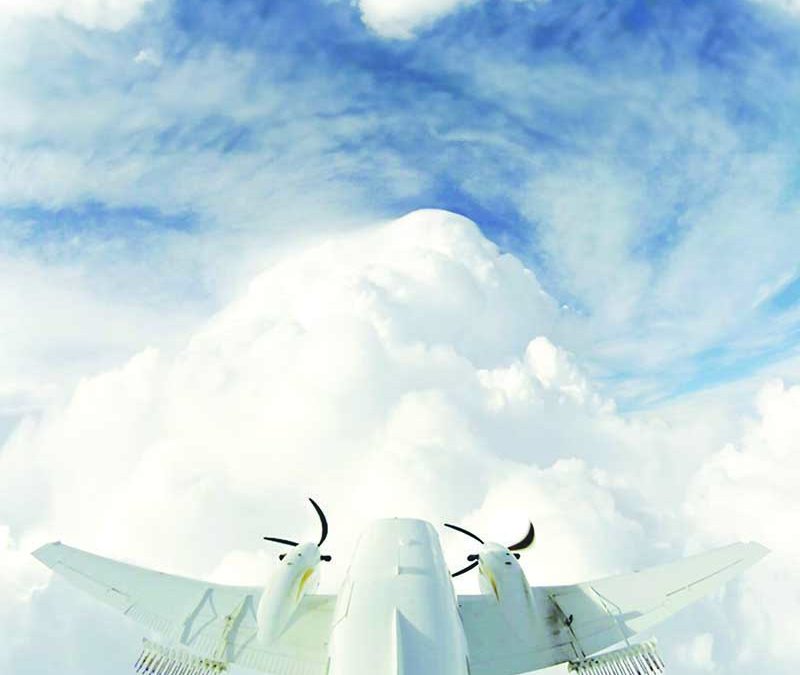Every snowflake starts with water drops and ice crystals congealing on bits of dust and pollen in the atmosphere. When enough water vapor freezes around those aerosols, gravity pulls them down as snow. Decades ago, scientists proved in laboratory settings that silver iodide could also anchor snowflakes, and in the 1970s, the U.S. Bureau of Reclamation tested that concept by seeding clouds in southern Colorado. But their final report was inconclusive on whether they were generating more snow, and if so, how much.
Some answers came nearly 50 years later in a zigzag pattern over Idaho’s mountains. As a plane sprayed silver iodide particles into a cloud, ground-based radars and airborne sensors tracked it. The instrumentation detected a line of snow that mirrored the plane’s flight path.
“It was this great breakthrough,” says Sarah Tessendorf, who studies weather modification with the University Corporation for Atmospheric Research and authored a paper on the Idaho study in 2017. “We were able to really prove that entire conceptual model that you can take a cloud with super-cooled liquid water and produce liquid on the ground thanks to seeding.”
That same research project also quantified an increase in precipitation of 5% to 30% in a single seedable storm, depending on conditions. Now, cloud seeding is seen as the rare lever water managers can pull to increase water supply through boosting winter snowpack. But research is still underway to characterize when it is best and most cost-effectively deployed, and to answer the critical question of whether cloud seeding really does boost precipitation and streamflow throughout an entire watershed over a season.
“We just consider it one of the tools in the toolbox that we have to combat the drought we’re seeing in the western United States,” says Andrew Rickert, who manages Colorado’s Weather Modification Program for the Colorado Water Conservation Board (CWCB).
The CWCB has permitted and grant-funded eight weather modification programs at water districts and ski areas in river basins across the state: a program in the central Colorado mountains, the Vail/Beaver Creek Program, the Upper Gunnison River Basin Program, a program on the Grand Mesa, the San Juan Mountains Program, the North Platte Basin Airborne Cloud Seeding Project, the North Platte Basin Ground-Based Program, and the St. Vrain and Left Hand Program. Each submits an annual report to the state with some including estimates as to how much cloud seeding changed their snowpack and others offering precipitation amounts for seeded and non-seeded storms. Of the $1.5 million the CWCB distributes per year, about a third comes from Lower Colorado River Basin states — California, Arizona and Nevada — hoping to see more water generated in the Colorado River.
The difference could amount to hundreds of thousands of acre-feet over the season, or what Rickert anecdotally estimates to be an 8% to 12% gain in snow per season, a number he calculates based on the amounts estimated in those eight programs’ annual reports. “At $2 per acre-foot, that’s just amazing bang for the buck,” Rickert says.
Then again, the impact may well be much lower. In 2018, results from an intensive cloud-seeding research project were published, reporting on a seeding study program in Wyoming from 2008 to 2013. There, researchers found that the seeding enhanced annual precipitation by just 1% to 1.5%.
Just one operation in Colorado uses a plane, and it’s a bumpy ride on wings prone to icing over. Most install equipment and generators in the mountains above around 8,000 feet in elevation to spray silver iodide thousands of feet overhead into clouds, cued by a remote operator on a distant computer as storms build.
“You have this window of opportunity where you have these clouds full of water drops that aren’t really doing anything,” says Frank McDonough, associate research scientist with the Desert Research Institute, which works on deepening the snow at Winter Park Ski Area and in the North Platte River headwaters. Seeding can compel the clouds to release snow when they might not, or snow a little more than they might otherwise. He’s had people stand in cloud-seeded areas and non-seeded areas and compare snowflakes and precipitation rates, and says, “We consistently see increased snowfall in our target areas.”
But seeding can’t prompt clouds to form, and clouds also decline with drought. Still, making a little more of snowy winters could boost reservoirs so they start the next dry spell closer to full.
One challenge with cloud seeding is that the U.S. Environmental Protection Agency lists silver and its compounds as a toxic pollutant and regulates its concentrations in drinking water, and at least one study found moderate toxicity risk for aquatic life. Humans exposed to high concentrations of silver can experience skin discoloration. Researchers, including Tessendorf, say silver iodide has been measured in the parts per trillion level in cloud-seeded areas, which is so low that it’s nearly indistinguishable from background levels. Concerns might only arise at a couple orders of magnitude greater concentrations, she added, but that does mean if a geographic region doubles or triples local cloud-seeding efforts, silver concentrations could increase. The Colorado Water Conservation Board plans to sample soils to monitor those levels.


 Print
Print